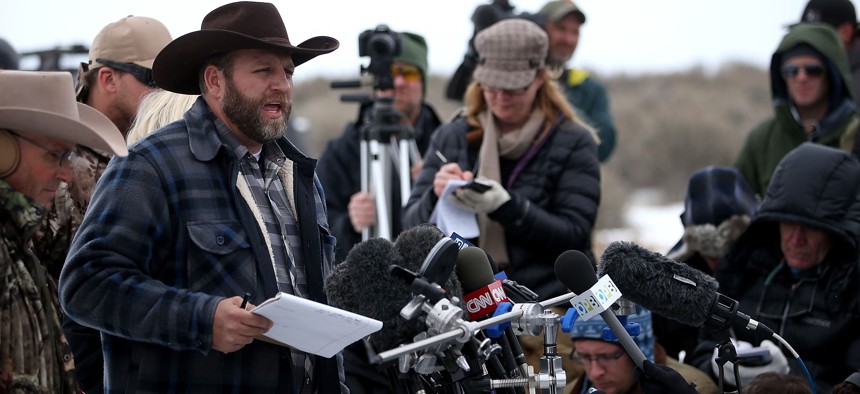
Ammon Bundy speaks to members of the media on Jan. 6, 2016. Justin Sullivan/Getty
That Time Armed Militants Occupied a Federal Building (Not the Capitol)
Before Jan. 6, 2021, there was Jan. 2, 2016.
The latest in an intermittent series looking back at groundbreaking, newsmaking, appalling and amusing events in government history.
The About Us section of the website for the Malheur National Wildlife Refuge includes a timeline of its history, beginning in 1908 with its creation by President Theodore Roosevelt as a preserve and breeding ground for native birds. The timeline ends in 2013, with the completion of a comprehensive conservation plan.
That means it doesn’t include a rather significant event in the refuge’s history: the time in January 2016 when a group of armed militia members invaded and took over Malheur’s headquarters. They encamped for six weeks, demanding that the federal government relinquish control of the refuge to local residents.
The very name of the wildlife preserve presaged trouble: “malheur,” translated from the French, means “misfortune.” The Malheur website notes the refuge “is famous for spectacular concentrations of wildlife, which are attracted to the refuge’s habitats and abundant water resources in an otherwise arid landscape.” But those water resources include not only Malheur Lake, but Mud and Stinking lakes as well.
Those who occupied the refuge had little interest in the wildlife there or its protection. They were out to strike a blow against the very idea that the federal government should own or control land that could be used by farmers and ranchers.
The group was led by Ammon Bundy, who had previously participated in an armed protest over grazing fees at the Nevada ranch owned by his father, Cliven Bundy, in 2014. Two of Ammon Bundy’s brothers also took part in the operation. They traveled to Oregon with other militants in late 2015, seeking to stop the imprisonment of Dwight and Steven Hammond, father and son ranchers who had been convicted of arson on federal land.
On Jan. 2, about 300 marchers descended on the town of Burns, Ore., near the refuge, to protest the Hammonds’ impending imprisonment. At the end of their demonstration, Ammon Bundy announced a plan to occupy the Malheur refuge headquarters, 30 miles to the south. A small group of militants joined him in taking over the facility and setting up defensive positions. Bundy and his followers pledged to stay in the building for years.
"The best possible outcome is that the ranchers that have been kicked out of the area…will come back and reclaim their land, and the wildlife refuge will be shut down forever and the federal government will relinquish such control," Ammon Bundy said in a phone interview with The Oregonian on the day the occupation started. "What we're doing is not rebellious. What we're doing is in accordance with the Constitution, which is the supreme law of the land."
A stalemate ensued that dragged on for 41 days. On Jan. 26, law enforcement officers intercepted a group of militants after they left the headquarters to attend a community meeting, killing one of them and arresting the others. The last holdouts of the insurrection surrendered on Feb. 11.
Dozens of occupiers were charged with various federal offenses related to their actions, and 12 pleaded guilty in August 2016. But in October, seven others, including the Bundy brothers, were acquitted of charges of conspiring to prevent federal employees from performing their duties. The militants never denied taking over the Malheur facility, the New York Times reported, but “their lawyers argued that prosecutors did not prove that the group had engaged in an illegal conspiracy that kept federal workers—employees of the Fish and Wildlife Service and the Bureau of Land Management—from doing their jobs.”
That characterization came despite the fact that the Fish and Wildlife Service was forced to spend $6.3 million in response to the insurrection. Much of the money went to relocating staff and their family members who were subject to threats and harassment during the siege. In the second week of the occupation, the local sheriff said FWS “employees and their loved ones have reported a number of uncomfortable incidences in which unknown individuals from outside our community have driven past slowly or idled in front of their homes, observing the residents and their activities. In addition, self-identified militia members have attempted to engage employees and family members in debates about their status as federal employees.”
The small number of employees who worked at the Malheur headquarters facility weren’t the only ones affected. “Buildings maintained by the Bureau of Land Management and Forest Service have also shuttered due to potential security threats to their employees,” Government Executive’s Eric Katz reported on Jan. 8. Almost all of the nearly 120 permanent and seasonal employees in BLM’s district office in Burns, Ore., were placed on paid administrative leave. The salaries of those workers totaled $117,000 per week.
Then-FWS Director Dan Ashe said after the Bundys’ trial that the agency was "profoundly disappointed” in the outcome, but “is committed to the security, healing and comfort of our Malheur National Wildlife Refuge employees.”
The headquarters and other facilities were closed for repairs and security upgrades until May 2017, when the visitor center officially reopened.







